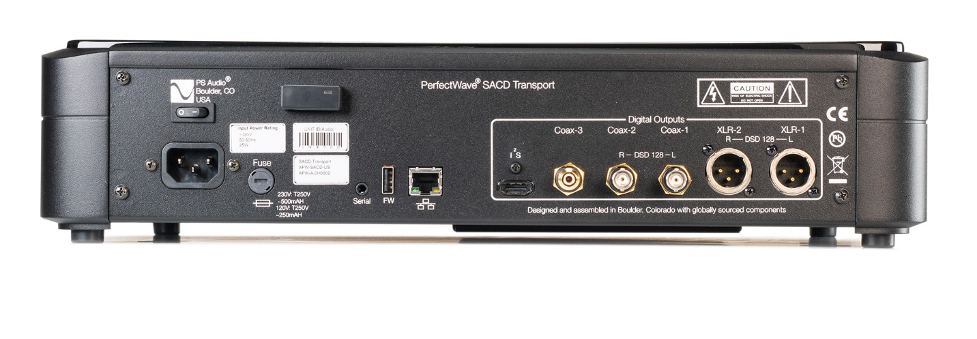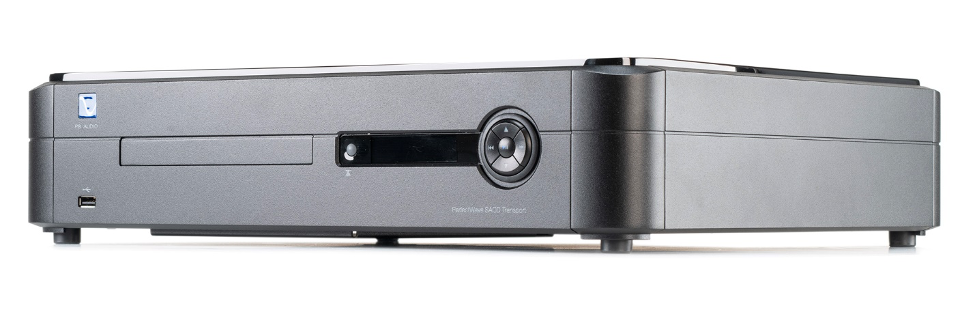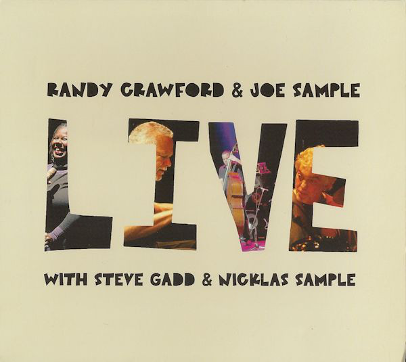
PS Audio has released a new CD/SACD transport, the PS Audio PerfectWave SACD Transport that they designed from the ground up. The bottom line for the designs of the circuits in this transport is to eliminate noise, jitter and ground issues that could mask musical information.
As soon as I heard about this new transport, I contacted PS Audio to get a sample for review. You see, I am one of those people who think that playing a CD/SACD on a transport still sounds better than any streaming service I have heard to date. To a lesser degree, it also sounds better than that same disc ripped to a solid-state hard drive. I must admit, however, the gap is closing fast. I recently added the Soundaware D300REF PCM/DSD network transport to my system. Still, when I want to listen critically to a digital source, I reach for a disc. I believe disc transports have a significant impact on sound. If you also subscribe to this thinking, then read on.
Enter the PS Audio PerfectWave SACD Transport
The new PS Audio PerfectWave SACD Transport (PST) was, in part, brought into existence when OPPO decided to exit the DVD/CD transport business. The original PerfectWave Transport (PWT) used an OPPO laser mechanism. Since the OPPO laser mechanism is no longer available, PS Audio was forced to make a choice. They could discontinue offering a CD transport as a product category or reengineer a completely new product for what from all metrics appears to be a shrinking market. Fortunately, they chose the latter.
Rethinking the Design
The PS Audio design team started with a fresh sheet of paper, so to speak. They had the freedom to rethink the entire signal path and discovered how much impact electrical noise and ground contamination were having on the digital signal. Since this noise was contaminating the signal, their goal became to eliminate as much of it as possible.
To that end, they developed their new Air Gap Galvanic Isolation circuit. They also used an updated version of their proprietary Digital Lens circuit. The Air Gap Galvanic Isolation circuit uses a beam of light. This beam isolates the drive mechanism from the Digital Lens circuit and makes the connection.

The PS Audio website goes on to describe the design of the PerfectWave SACD Transport this way:
“Engineers have worked for years with shielding and advanced grounding technologies in an effort to keep noise levels at legal levels (let alone quiet levels). The most effective means of removing noise is by physically distancing noisy components from quiet ones and most important, electrical isolation. The standard means by which digital audio subsystems are interconnected is by the use of wires in the signal and power paths. These interconnecting media radiate high frequencies throughout the circuit and make noisy environments worse. PS Audio’s solution is to both physically and electrically isolate PST’s output stage: no wires, no ground connections, no common power supply interactions. Inside PST there are two completely separated power supplies: one for the noisy electronics, a second for the quiet output stage. Signals are transferred by a form of focused beam short-wavelength radio signals between the two boards.”
Paul McGowan tells me that PS Audio will use this new isolation circuit in all their digital products.
The Digital Lens Circuit
While the Air Gap Galvanic Isolation circuit is new, the Digital Lens circuit was originally conceived and implemented in 1993. PS Audio’s CEO Paul McGowan and Chief Engineer Bob Stadtherr decided to buffer and reclock the digital data coming off of the CD. Over the years, they have continued to improve this circuit. It now addresses timing, noise, and isolation problems. They have also added FPGA programming to the data buffer/transfer. In the latest version, the revised FPGA signal processing/clocking and buffering on the PST takes this circuit to a new level.
More About the Design
The unit itself is available in black or silver in what has become a familiar PS Audio component design. A very stylish aluminum chassis with rounded corners houses the mechanism, and it has a striking painted acrylic gloss black top.
Data outputs include S/PDIF, AES/EBU, or I2S. You can obtain double-rate DoP (DSD over PCM) by connecting both AES outputs or both BNC outputs to a compatible DAC. It has built-in wifi (that can be defeated) and ethernet connectivity for future firmware upgrades that may be offered.
Like the original PWT, the PST has the unique feature of being able to unlock the pure DSD layer on an SACD disc via the I2S output when connected to a compatible DAC like PS Audio’s DirectStream DAC. My Denafrips Terminator Plus DAC worked flawlessly with this feature. I’ll add a bit more on this later.

Moving around to the front of the unit, you will see a front panel control ring and a load/eject/menu button. There is also a power button, and a USB slot to playback music from USB storage. I am not a big fan of a control ring, primarily because the buttons typically are multi-function. It doesn’t help that my fingers are like tree stumps! On the PST, the button functions vary with a long or short press. For instance, a short press on the down button puts the player in a fast rewind mode. However, a long press toggles the time display between counting up or down.
A Few Design Misses
As with any component, there are always things about the design that miss the mark for me, and I wish they were a little different. For the display, I was sad to see the size decrease from the original PerfectWave Memory Player. I found the track number itself to be a bit undersized and hard to read from my listening chair. Perhaps in a future firmware version, PS Audio can provide a display mode that fully allows for displaying the track number. It would also help to thicken the track number graphic, much like the volume indication on the BHK preamp, which works quite well.
I also much prefer the larger display window of the earlier PWT. I suspect the new layout allows for more efficient use of similar chassis within the PS Audio line. Perhaps the size change had to do with a noise issue with the larger display. To replace the discontinued OPPO drive, PS Audio chose a D&M SACD/CD drive for the PST that are used in several high-end transports. The mechanism operates very smoothly. However, I found it to be a bit touchy about the placement of the disc in the drawer. On a few occasions, I would load a disc only to be told there was no disc. I would have to open the drawer and reposition the disc and all would be fine. You simply need to be a bit more deliberate about how you place the disc in the tray to avoid this issue.
Remotely Speaking

The included remote-operated flawlessly, and I am sure it will be fine for the vast majority of owners. I will point out, however, that it has 47 buttons! This one remote is meant to control all of your PS Audio components.
This is a noble idea, but in real-world use with just one component, I found it to be a bit cumbersome and distracting. I would much rather have a smaller, less busy remote specific to the PST with transport functions that would offer a better ergonomic layout.
The remote also omits the ability to engage and move thru the PST’s sub-menu system. This is where you select options such as wifi setup or vary the display brightness level. It’s also where you can turn the display on/off from the remote.
Currently, you have to use the control ring on the unit to select the output of the PST. Your choices are DSD, Stereo down-sampled SACD, or Redbook PCM. Perhaps it is a technical issue, but it would be nice to be able to control these selections “on the fly” from the remote. Hey, one can hope.
Now About the Setup
I have retained several transports over the years. For this review, I chose my long-time reference, the McCormack SST-1 (modified) along with an Esoteric X-03SE. I set the transport that was up for comparison and the PST side by side and used an identical power cord and digital cable (usually SPDiF although I used AES and SPDiF with the Esoteric).
I used my Terminator Plus DAC for the comparison. The balanced outputs were routed to my Denafrips Athena preamp. I also used the PS Audio M1200 monoblocks, Quicksilver MS-190, and the First Watt SIT-3. The speakers were my personal Acoustic Zen Crescendo II and the Volti Audio Razz V.2 speakers that are currently in-house for an upcoming review. Cabling was Triode Wire Labs and Audience.
So, Let’s Do This…
Well, there is no other way to put this. Right out of the gate the PST spanked every transport I compared it to. Frankly, I did not expect a degree of improvement. The PST bettered each transport to varying degrees in the areas of soundstage layering, instrument separation, resolution of low-level detail, and PRaT. Music was much more involved and interesting through the PST.
Randy Crawford Live

On the Randy Crawford Live disc, the PST made the other transports sound considerably more two-dimensional. Her vocals had more depth and expressiveness, and the piano had more tonal color. Also, the audience was better resolved when played on the PST. These improvements made it much easier for me to be drawn into the live concert.
Nnenna Freelon LIVE

The differences between the PST and the other transports were again were very dramatic when I listened to the Nnenna Freelon LIVE disc. With the PST, the performance had more depth and tone and blacker background. The bongos had more body and density, and the guitar work was more dynamically expressive with a considerably richer tone. The vocals had more dimension and body to them. I became more engaged with Nnenna’s performance and formed a more emotional connection with her.
Throughout my weeks of comparisons, the results were VERY consistent. The PST always provided a more involving musical presentation. It also had greater transparency, tonal structure, texture, and soundstage than the other two transports. What was a revelation is that before hearing the PST, I did not think the SST-1 or Esoteric X-03SE was obscuring much data. But once I heard the PST, there was simply no going back. A comparison that comes to mind is the use of polarized sunglasses. When you are looking through standard sunglasses, you feel that all the information is there. Then you put on a pair of polarized glasses, and they remove glare that is obscuring detail. The colors become richer with more depth. The PST offers up a “polarized” version of the music. It is more transparent and presents a sound with more body and dimensionality.
The DSD/I2S Feature
With the outright transport comparison behind me, I moved on to trying the DSD/I2S feature of the PST. I have not devoted a lot of energy to SACDs in the past. While I do not have a large selection of SACDs, I did want to confirm its DSD layer playback on my Terminator Plus.
Then I pulled out my Norah Jones Come Away with Me and my FIM version of Antiphone Blues. I used a .5m HDMI to go from the I2S output of the PST to the I2S input on my Terminator Plus. On the PST, you access the DSD layer of an SACD by going to the Sub Menu. To do this, you engage the same button that ejects the disc until the menu appears in the display. You can then cycle through the menu to get to the “LAYER” option. This option enables you to choose CD or SACD output through your I2S cable. This is engaged by pressing and holding down the same button that ejects the disc until the menu appears in the display.
Once I started the SACD, the display on the PST showed “SACD DSD64”. The DSD light on my Terminator Plus lit up, and I was ready. Comparing the DSD layer to the CD layer, the DSD layer sounded more relaxed. It offered a better sense of space with an improved resolution of low-level detail. In all of my comparisons, the SACD DSD layer outperformed the CD layer. While this was not a total surprise, it has forced me to recalibrate my thinking about SACD playback in general. My past experience with SACD playback was not as convincing as hearing the DSD layer played back on my system was. I am looking forward to getting additional SACDs and exploring this further.
Another SACD Comparison

In another comparison, I pulled out my SACD of Fan-Ya-Yin titled Emerging that I picked up when she was playing in the lobby at RMAF several years ago. This is one of the excellent IsoMike recordings done by Kimber Kable. Here the PST/ Terminator combo yielded more harmonic information and density. It moved me closer to the music than the SACD playback from the Esoteric X-03se. There seemed to be less between me and the piano. The music seemed to flow easier, and it sounded more natural to my ears on the PST/Terminator combo.
Granted, there are a LOT of variables in this comparison, the biggest of which was that I was in essence listening to two different DACs. But, I did want to give it a listen on my system, and it will require further investigation. I will leave those comparisons to someone else who has more extensive experience with SACD sound/playback than I have.
Note, it’s easy to compare the SPDiF, AES, and I2S outputs since all of the outputs on the PST are simultaneously active. Be aware that there are a lot of caveats in this type of comparison since you are not solely comparing the outputs of the PST. You are also comparing the inputs of the DAC and the impact of different cables. Nonetheless, I concluded that on my system the preferred output was AES. It offered overall a bit more “meat on the bones” than the SPDiF or I2S. Please remember that, at heart, I am a vinyl/tape person and take this conclusion with a shaker of salt. You will draw your own conclusions based on your setup and listening priorities.
Thank You, It Was a Pleasure!
Frankly, this is one of the easier products I have had the pleasure of reviewing because we are not splitting hairs here. The PerfectWave SACD Transport was consistently better than the other transports I threw against it in almost every category. It took my digital front end to a level I did not know it was capable of. Limitations that I previously thought were inherent in the Redbook format were significantly reduced, primarily in the areas of soundstage depth and the resolution of low-level detail.
What it does for Redbook CDs may be worth the price of admission in itself. I spent many a night listening to CDs I have heard many times. With the PST they were more revealing and engaging than I have heard before. Add to that the access to the DSD layer on your SACDs and you have quite a package as a source for your system.
The Price of Admission
Now, let’s talk about the price of admission. There are several excellent disc transports out there. While I have not experienced them all, I would comfortably speculate that the PerfectWave SACD Transport will give them a run for the money. The PST runs $6,499.00. However, with the always available PS Audio Trade-in program, you could obtain it for as low as $3,999.00. Does that represent a good value? Well, as the saying goes, “Value is in the pocketbook of the beholder.”
If you have a large CD/SACD collection and are in the market for an exceptional transport, the PST needs to be on your shortlist of units to audition. To omit it would be to deprive yourself of experiencing some of the best CD/SACD playback you may have heard. I suggest you take advantage of PS Audio’s 30-day trial and then decide how wide you are willing to open your pocketbook.
Highly recommended for your consideration!
Price $6,499.00
Short Interview with Paul McGowan, CEO of PS Audio
During the review period, I submitted some questions to Paul McGowan about the transport. I thought you might like to read my questions and his answers.

Ken: Considering the downward trend in sales of physical digital media, what drove you to invest company resources in developing a new CD/SACD transport?
Paul: Definitely our last and best effort here. Even though sales are way down on physical media it’s clear to us the majority of our customers still have large CD/SACD collections. They need something to play them on. We wanted to produce a device that would serve them into the future or until such time they convert over to streaming.
Ken: Do you fall into the camp that believes playing a physical disc sounds better than a ripped copy played off of a Solid State hard drive?
Paul: No, I do not. What we have discovered is that they all sound different but much of that has to do with the noise and interaction of the electronics and power supplies processing the data. Once we finally finished the work on our galvanic isolation circuitry those differences have vanished. The trick is in completely isolating and then reclocking the isolated data so that what the DAC sees has no direct electrical connection to the inner electronics of the transport.
Ken: What optical drive did PS Audio choose to base the PWT transport around and why?
Paul: We went with the D and M mechanism which is the same one Marantz uses. It’s an expensive but extremely well-built Japanese manufactured design.
Ken: Can you describe the new galvanic isolation and what it impacts?
Paul: It impacts everything. The first track we listened to comparing the older DirectStream Memory Player without galvanic isolation vs. the newer PerfectWave SACD Player was a real jaw dropper. The only real difference that would account for this is the use of our AirGap isolation circuit. By removing any and all physical and electrical connections (including common grounds and power supplies) with the processing circuit, we have eliminated the final vestiges of problems in digital audio.
Ken: Do you see future applications for this new galvanic isolation, perhaps in the new upcoming Perfect Wave DAC?
Paul: Absolutely. It will become the basis of all PS Audio digital audio products going forward.

Excellent accurate review in my opinion as my experience with disc placement and sound quality matches the review. I also rate the transport as the finest I’ve heard producing SACD. I use it with the HOLO AUDIO MAY KTE via I2S which easily betters anything else I have owned from Ayre, Bryston Chord.
Yes indeed Chris. I found this to be a significant step forward in disc playing. Glad to hear of your similar experience with the PST transport.
I am looking forward to PS Audio’s application of there ‘Air Gap” technology in future digital products.
Thanks for reading The Beatnik. -ken
@ Ken Redmond: Please forgive my nit-picking your otherwise perfectly fine reply to Chris’s observations: I have to totally empathize with you – because you are NOT alone in typing ‘there’ when clearly you meant to say ‘their’ “Air Gap” technology.
I am seeing this fundamental spelling error ALL THE TIME now (provided it’s not merely a typo) – which is centered around three completely separate words, each with its own entirely different meaning, but all three of them when we hear them spoken out loud, sound totally alike: 1) THERE – meaning the LOCATION of a person or object – “He’s over THERE leaning against the wall, not over HERE standing beside me next to the coffee table.” – 2) THEIR – meaning something BELONGING TO a person – “The green car is THEIR 2019 Subaru Hatchback – not MINE, which is pearl-white.” 3) Then we have THEY’RE – a contraction of the verb ‘THEY ARE’ – as in, “Please don’t disturb the two chefs right now – THEY’RE preparing the barbecue sauce.”
Sigh – this shows how badly our educational system all across the country has suffered in recent years – even the best-educated of us have been cheated by it.
Hi Jos,
Sorry, but in this case, it is simply a typo and not an indictment of our entire educational system.
Sister Mary ( ruler on the knuckles ) Joseph was my English educational system and I will have the correction made in her honor.
Keep reading The Beatnik and enjoy your music! -ken
Excellent and thorough review!
I purchased the PerfectWave SACD transport and all you state is in evidence.
One issue that has not been addressed is that of volume.
The PerfectWave is 5 – 6 DB quieter compared to my Ayon 1 SC – both using the same DAC, same IC and CD song !
How can a transport effect volume?
I used a DB meter to determine my standard listening levels using my Ayon CD transport/player – about 78 DB, which equates to -23 DB on my M3 DAC.
On the PW transport, I need to raise the M3 volume to -18 DB to reach 78 DB.
As my SE Triode amp is being pushed too hard, I raised the concern to PS Audio and I am waiting for a response. Any ideas?
Hi! Which I2S pin layout on the MAY KTE did you use for the PS Audio Sacd transport as a source?
Thanks!
Roi
Ken Redmond
9:36 AM (0 minutes ago)
to WordPress
Hi Roi,
I did not have access to a MAY KTE DAC with the PS Audio SACD Transport..
My I2S listening was done with a Denafrips Terminator Plus which allowed me to cycle through the configurations until I got a signal.
Actually, I got a signal on two of the configurations….. but only one had the correct Left-Right channel . The other was reversed, so pay attention to that.
And don’t overlook the AES input…..
The SACD transport / MAY KTE should be a very good sounding combination.
Enjoy…. Ken
Hi, thank you for good review on ps audio CD transport. I own Terminator 2, and would like to use perfect wave to access SACD playback. Is it plug and play or do you have to configure the Terminator 2 to accept the DSD? Can you please help?
Thank You
Ganesh.
Greetings Garnesh,
Thanks for the kind words on the review and thank you for being a Beatnik reader…
After you connect the I2s output of the PS Audio transport to the I2s input of the Terminator via an HDMI cable ( short as possible..no more than 1 meter) you have the following two steps to do
First you have to set the PS Audio transport to default to DSD output on SACD disc.
You access this in the setup menu of the PS Audio Transport and the procedure is in their manual.
Second you have to configure the I2s protocol on the Terminator to match the PS Audio’s.
There are a number of YouTube videos that Denafrips has produced that walk you through this..
Once that is done, you are good to go and will get the raw DSD layer off of the SACD .
Enjoy the music !!
Hello Ken, thank you for your reply. I have waited a long time and spent a lot time and money to get a proper SACD player. But up to now non did what the perfectwave transport has done. The SACD players all come with their own DAC, and they don’t sound the way I want it to sound till now. I love the Terminator 2 sound and soundstage, but up-to now there was not a cd transport which could do, what the ps audio cd transport could do. Now the possibility’s are endless.
Thank You, for time.
Ganesh,
Indeed, that will be a rewarding combination that will let SACD shine.
Sit back and enjoy ..
-ken
After about four months, I have come to appreciate the PS Audio PW SACD for what I believe it to be- A truly 1st-rate optical transport with outstanding implementation of SACD playback. It is graveyard quiet with a natural and open sound with tremendous presentation of details and space. You need not feel left out if you have a large CD collection as 44/16 format is so well done that you may not have fully heard CD at is best. The improvement on CD has been positively remarkable. I use the PW SACD with the Holo May KTE, ARC Ref 3 preamp, SMc Audio DNA 1 to Thiel 3.7s. I am not convinced that the UI and display are up to the price tag, but beyond that, without spending many, many times the asking price, I am not sure one could do any better. This combo has been the best in my room/system of any of the other digital front ends that I have heard. No hype, just excellent audio engineering with an excellent result…
Andre, I certainly agree with your sonic evaluation of the PS Audio PW SACD. I continue to be impressed with its Redbook ability and it opened a new world of SACD listening to me. I agree with your comment about the display and raised that issue in my review but I am happy to trade that shortcoming for the sonic performance it delivers. Thanks for taking time to comment on your experience with the PW SACD transport and I was glad to read it mirrored my experience with the unit.
It’s great to see further interest in SACD, but the PS Audio Transport does not address the whole problem. We need a player for all disc-based music, including DVD audio and Blue Ray Audio. Oppo (and other universal player makers) used to provide that functionality at 1/4 the cost of the PS Audio unit. For $6500, the music consumer deserves better.
Does it handle red book and ripped SACD DSD *better* than a quality streamer, like Innuos Zen Mk3? Contemplating one or the other, as I have both my original CD/SACDs close at hand and lossless rips handy as well, both playable through a DSDac. Thoughts?
Hi Jeff,
Well….. There are a LOT of variables to consider in your question. I am quite familiar with the ZEN MK3 and it is a very good streamer /server, especially with the new 2.0 software.
However, as you know, these are not two equally featured products. The ZEN can stream, the PS Audio can access the DSD layer of a SACD when used with a DAC with a compatible i2S connection among other differences.
Other determining factors would be the depth of your CD/SACD collection.
But if you just focus on CD/SACD playback, as a general statement, I personally prefer to spin the disc when I can.
I do have 8TB of lossless ripped music on a hard drive, but for critical listening I will spin the disc when I can.
Hope this helps…
Would the transport play well with Chord Dave hooked up with AES/ebu Transparent reference series?